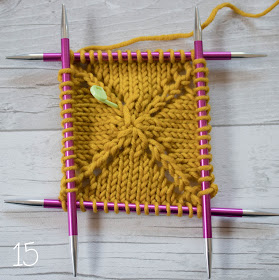Diamond Haven Blanket
I was very honoured to be asked by Love Knitting to design a
blanket for the Breast Cancer Haven. It is an amazing charity that supports
women through their breast cancer treatment. When breast cancer tries to rob a
woman of her individuality, her confidence or her strength, they provide the
tailored package of emotional, physical and practical support that helps her
hold on to them.
The blanket is modelled by service user Alexia: “At first I wasn’t able to talk to other people about my diagnosis, but through my time at Breast Cancer Haven, I’ve realised how important it is to connect with others. Breast Cancer Haven is a special place and a great support network, it’s given me support to love and care for my mind and my body. They also gave me the tools and confidence to discuss my diagnosis and treatment with others.”
All proceeds from the sales of this pattern will be donated
to Breast Cancer Haven in support of the The Big Tea Cosy, which takes place
March 1-31, 2018, and raises money and awareness for Breast Cancer Haven. If
you’d like to donate your project, you can send it to Haven's London centre
where they will be gifted to breast cancer visitors.
Download your free message
tag, and find the address here.
When designing the blanket, I wanted the making of the
project to be easily portable, so the maker can take it along and work on
trains, planes and buses! Of course, It had to be soft to bring comfort so MillaMia
Naturally Soft Aran yarn was the perfect choice as it’s insanely soft, and it
comes in a beautiful range of colours. I have chosen greys and yellow, as I’m
slightly obsessed with this colour combination and yellow is a very happy
colour, symbolising sunshine and happy times, hoping it will bring comfort to a
person going through very tough time.
The blanket is constructed out of individual squares which are then joined together.
There are two types of squares, one plain stocking stitch and one lacy. Each
square is knitted from the centre out, which gives the makers full control of
how large you would like the squares to be. Garter stitch border finishes each square in
one colour, when the squares are joined together this gives a lovely definition
to the centre of each square.
The squares are knitted from centre, which means you will
work using 5 double pointed needles (DPN) and start with provisional cast on. I have created a little tutorial below to help you get started.
There are many techniques out there how to work a
provisional cast on, I want to show you one that I use the most and this method
requires a crochet hook.
Provisional cast on is a way of making a temporary cast on,
one that can be easily removed and will give you live stitches on your needles
so you can continue to knit, unravel or cast off. It is especially useful when
starting the squares of this blanket as you can just pick up the live stitches while
unpicking the crochet edge and gather them tight to close up the centre of the square.
The blanked is knitted using 5 x 5mm (US 8) DPNs, you will
need 5.50mm (US I/9) crochet hook, scissors and tapestry needle, main yarn for the square
and waste yarn in contrasting colour. I use a hook a bit bigger than the needles as I want to make bigger chains for ease of working into them.
1: Using the waste yarn in contrasting colour (so you can see
it when you unpick at the end) make 10 chains, I always like to make 2 more
chains than the number of stitches needed for my project, few extra chains
just in case. Cut the waste yarn and pull it through last chain to secure.
If you look at the right side of your chains you will have a
row of Vs, if you look at the wrong side you will see a row of ‘bumps’, we will
work into these bumps.
2, 3 & 4: Using the yarn and one DPN that you will use for your
project, leaving a tail of around 15 cm (6''), pick up and knit a stitch in the
‘bump’ of each chain until you have 8 sts.
5 & 6: Separate the stitches onto 4 DPNs, you will have 2 sts on
each needle.
7 & 8: Using the 5th DPN start working in the pattern, until you reach a good size to
comfortably unpick the provisional cast on or until you finish the square.
TIP: When you knit few rows place a marker to denote the beginning
or round. I found it very useful to pin
a lockable marker into the beginning few rows of my work, as working on DPNs
and placing the marker on the needle causes it to fall off constantly (pic 8).
9: When you are ready to unpick your provisional cast on,
thread your main yarn tail through a tapestry needle.
10: With right side facing
and using the tapestry needle unpick the knot you made at the end of your
chain.
11: Carefully pulling on the tail, unravel one stitch at the
time, as each stitch becomes free, slip it on the tapestry needle.
12 & 13: Once all the chains have been removed you have lovely live
stitches on your tapestry needle.
Pull tight on the tail to close up the opening.
14: Push the tapestry needle to the wrong side of work and weave
in the tail around the centre to secure.
15: Hey presto! One square finished with a lovely neat centre.
Hope you all enjoy knitting the blanket and helping such a
worthy cause.
Anna x
































